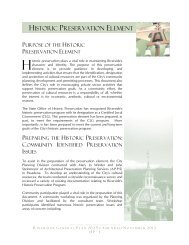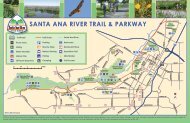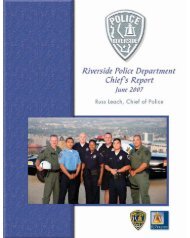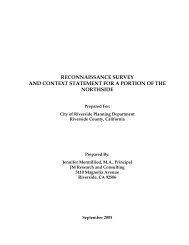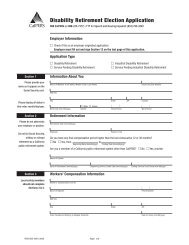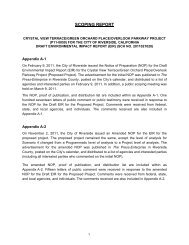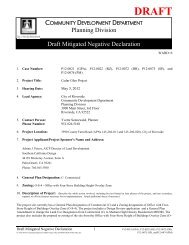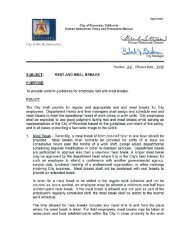Airport Master Plan - City of Riverside
Airport Master Plan - City of Riverside
Airport Master Plan - City of Riverside
Create successful ePaper yourself
Turn your PDF publications into a flip-book with our unique Google optimized e-Paper software.
(3) capable, under dry conditions, <strong>of</strong><br />
supporting snow removal equipment,<br />
aircraft rescue and firefighting<br />
equipment, and the occasional<br />
passage <strong>of</strong> aircraft without<br />
causing structural damage to the<br />
aircraft, and;<br />
(4) free <strong>of</strong> objects, except for objects<br />
that need to be located in the<br />
RSA because <strong>of</strong> their function (in<br />
aiding air navigation).<br />
The dimension <strong>of</strong> the RSA surrounding<br />
the runway is a function <strong>of</strong> the<br />
critical aircraft. The current critical<br />
aircraft is in ARC B-II. Future planning<br />
will consider a critical aircraft in<br />
ARC C-II. The existing B-II RSA serving<br />
Runway 9-27 should be 300 feet<br />
wide (centered on the runway) and extend<br />
600 feet beyond each end <strong>of</strong> the<br />
runway. The future ARC C-II RSA is<br />
400 feet wide but requires 1,000 feet <strong>of</strong><br />
RSA beyond the far ends <strong>of</strong> the runway<br />
and 600 feet prior to the landing<br />
thresholds. Since operations are performed<br />
to both runway ends, depending<br />
on wind conditions, the future RSA<br />
effectively needs to extend 1,000 feet<br />
beyond each runway end.<br />
FAA Order 5300.1F, Modification <strong>of</strong><br />
Agency <strong>Airport</strong> Design, Construction,<br />
and Equipment Standards, indicates<br />
in Paragraph 6.d the following:<br />
“. . . Runway safety areas at both certificated<br />
and non-certificated airports<br />
that do not meet dimensional standards<br />
are subject to FAA Order<br />
5200.8, Runway Safety Area Program.<br />
Modification <strong>of</strong> Standards is not issued<br />
for nonstandard runway safety<br />
areas.”<br />
The FAA placed a greater emphasis on<br />
meeting RSA standards with the publication<br />
<strong>of</strong> FAA Order 5200.8, Runway<br />
Safety Area Program, in 1999, following<br />
congressional direction. The Order<br />
states in Paragraph 5, “The object <strong>of</strong><br />
the Runway Safety Area Program is<br />
that all RSAs at federally obligated<br />
airports and all RSAs at airports certified<br />
under 14 Code <strong>of</strong> Federal Regulations<br />
(CFR) Part 139 shall conform to<br />
the standards contained in AC<br />
150/5300-13, <strong>Airport</strong> Design, to the extent<br />
practicable.”<br />
The Order goes on to state in Paragraph<br />
8.b:<br />
“The Regional <strong>Airport</strong>s Division Manager<br />
shall review all data collected for<br />
each RSA in Paragraph 7, along with<br />
the supporting documentation prepared<br />
by the region for that RSA, and<br />
make one <strong>of</strong> the following determinations:<br />
(1) The existing RSA meets the current<br />
standards contained in AC<br />
150/5300-13, <strong>Airport</strong> Design.<br />
(2) The existing RSA does not meet<br />
the current standards, but it is<br />
practicable to improve the RSA<br />
so that it will meet current standards.<br />
(3) The existing RSA can be improved<br />
to enhance safety, but the<br />
RSA will still not meet current<br />
standards.<br />
(4) The existing RSA does not meet<br />
current RSA standards, and it is<br />
not practicable to improve the<br />
RSA.”<br />
4-7



